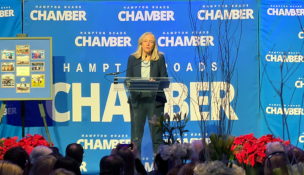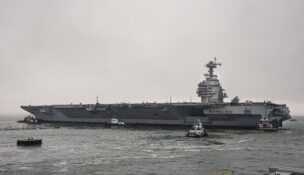
A group of more than 100 organizations are involved in developing the Virginia Ocean Plan. Photo courtesy Virginia Tourism Corp.

A group of more than 100 organizations are involved in developing the Virginia Ocean Plan. Photo courtesy Virginia Tourism Corp.
Va. Ocean Plan taking shape for 2025
As coastal populations grow and traditional and novel maritime industries increase their use of the Atlantic Ocean, the state government is developing a comprehensive plan to support the coexistence of different uses of the ocean.
A group of more than 100 stakeholders — including the Bureau of Ocean Energy Management, the Army Corps of Engineers, the U.S. Department of Energy, the U.S. Coast Guard and the National Oceanic and Atmospheric Administration — are developing the Virginia Ocean Plan, a document that is set to come out in a public draft next year.
There are six workgroups focused on different aspects of the plan: fishing and aquaculture; cultural and historic resources; seafloor resources; energy and infrastructure; sustainability and conservation; transportation navigation and security.
“Virginia has the largest naval base in the world, the deepest port on the East Coast, one of the largest commercial seafood industries on the East Coast and the largest offshore wind farm in the U.S., with more on the horizon,” notes Ryan Green, who manages the Virginia Coastal Zone Management (CZM) Program under the state Department of Environmental Quality. “It’s important to have coordination and collaboration across these uses.”
One area of conflict, Green says, has been between offshore wind and commercial and recreational fishing, so the plan will include maps of fishing areas in relation to ocean floor leases for wind farms.
“We want to make sure other users are considered and given plenty of opportunities to weigh in,” Green says. “It’s helpful to have a cross-cutting discussion driven by stakeholders and the public.”
Todd Janeski, Virginia Commonwealth University’s natural resources program manager, says that wind farms, subsea cables, sand mining and changes in shipping lanes have also impacted commercial fishing.
“The commercial fisheries industry is very apprehensive about changes in ocean use,” he says. “How do we better coordinate around those issues to be more efficient and address conflicts?”
Although Green acknowledges that these deadlines are “moving targets,” an internal draft of the ocean plan is expected to be completed in early 2025, while a public draft will be available in the second half of the year.
“We want it to be as close to a consensus process as it can be,” Green says. “We plan for this to be a living document. As new opportunities are being developed, we will continue to revise it.”
-
















